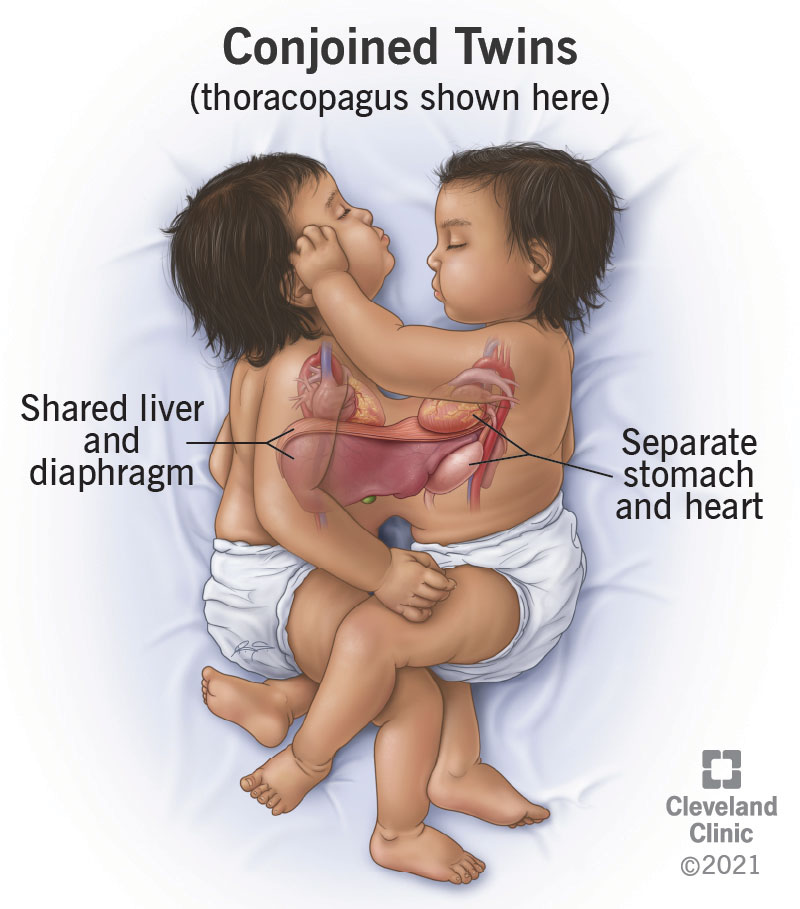Can These Conjoined Twin Sisters Be Separated Safely?
These conjoined twin sisters are heading on a journey that could potentially change their lives forever. Follow them and their family as they travel to a hospital in the Philippines to find out if they can be separated safely. attached at the forehead have undergone tests to begin the process of separating them
Conjoined Twins
Cleveland Clinic is a non-profit academic medical center. Advertising on our site helps support our mission. We do not endorse non-Cleveland Clinic products or services.

What are conjoined twins?
When two babies are physically connected to each other at birth, they’re called conjoined twins. Experts don’t know exactly what causes the condition. But it likely involves splitting or fusion of very early-stage embryos soon after fertilization. All conjoined twins are identical, and about two-thirds are assigned female at birth (AFAB).
How common are conjoined twins?
Conjoined twins are rare. It’s estimated to occur only once in every 50,000 pregnancies. Because the conjoined anatomy is sometimes incompatible with life, many conjoined embryos will not survive. Up to 60% of conjoined twins are stillborn (not alive at birth) or die shortly after delivery.
Are conjoined twins always identical?
Yes. Conjoined twins are always identical. They’re also more likely to be female.
What causes conjoined twins?
There are two theories of what causes conjoined twins:
- Fission: An early embryo, comprising a small sphere of identical cells, splits into two spheres but doesn’t separate completely. The two spheres each develop independently into the conjoined twins.
- Fusion: An identical twin pregnancy contains separate early twin embryo “spheres” that merge together and join at a random point of connection.
Both of these theories help explain how conjoined twins might form during the first 12-14 days of fertilization. But scientists still don’t know why this happens.

What are the types of conjoined twins?
Conjoined twins are identified by specific terms. These terms describe the point of connection. Twins may be conjoined at the:
- Abdomen (omphalopagus).
- Chest (thoracopagus).
- Top of head down to the belly button, facing each other (cephalopagus).
- Head only (craniopagus).
- Pelvis, facing each other (ischiopagus).
- Pelvis, side-to-side (parapagus).
- Rump-to-rump (pygopagus).
- Vertebral column (rachipagus).
Diagnosis and Tests
How are conjoined twins diagnosed?
Conjoined twins can be identified as early as 12-weeks prenatally through imaging tests, including:
If imaging tests show that twins are conjoined, healthcare providers will try to predict potential complications. Then they’ll make a plan to address them at the time of birth.
Management and Treatment
Are there complications during pregnancy with conjoined twins?
It is very common for birthing parents to experience premature labor with conjoined twins. With early detection, the pregnancy can be managed to prevent pre-term labor and allow the twins to develop normally.
Delivery by C-section is the most common way to manage this situation.
Can conjoined twins be separated?
Sometimes. Successful management usually involves several medical and surgical specialists. Sophisticated imaging techniques and other tests can help sort out the anatomy and physiology of both twins. The decision to attempt separation or not can bring up difficult ethical questions. These questions are usually discussed at length between the parents, the medical team, and often clergy and medical ethicists.
In some cases, it’s possible to separate conjoined twins. The procedure to separate twins always takes extensive planning by a team of highly experienced surgeons.
After conjoined twins are born, they are grouped into one of three categories:
- No separation: If separation would pose life-threatening risks to the twins or result in extreme disabilities, surgical separation would only be attempted after consideration of all quality-of-life issues.
- Immediate separation: Sometimes emergency surgical separation is required to save the life of one and/or both twins.
- Delayed separation: When the twins are stable from a health standpoint, your medical team may delay separation surgery. This gives the twins time to grow and develop — and it increases their chance of survival. Many healthcare providers feel that surgical separation should take place when conjoined twins are 9 to 12 months old. This way, they can be separated before the condition takes a psychological toll. Twins who experience delayed separation have a higher survival rate (80%) over twins who need immediate separation.
Prevention
Can conjoined twins be prevented?
Since the cause of conjoined twins is unknown, there’s no way to prevent conjoined twins from occurring during pregnancy.
Outlook / Prognosis
What is the prognosis for conjoined twins?
Survival rates and quality of life for conjoined twins depend entirely on how the two babies are connected. Here are the survival rates for each type:
- Abdomen (omphalopagus): 82%.
- Rump-to-rump (pygopagus): 68%.
- Pelvis, facing each other (ischiopagus): 63%.
- Chest (thoracopagus): Poor.
- Pelvis, side-to-side (parapagus): Poor.
- Top of head to bellybutton (cephalopagus): Poor.
- Head only (craniopagus): Poor.
- Vertebral column (rachipagus): Cannot be separated.
If separation surgery is attempted, only 60% of surgically separated conjoined twins survive. Healthcare providers can manage complications to improve the outlook for conjoined twins.
Can conjoined twins lead a healthy life?
Depending on how the twins are joined, conjoined twins may live fully functioning lives thanks to advancements in surgical separation. Some conjoined twins who can’t be separated can still enjoy a good quality of life if they’re closely monitored.
Living With
During pregnancy, when will I know if I have conjoined twins?
Conjoined twins can be identified as early as 12 weeks into your pregnancy. Your provider can usually confirm this around the 20-week mark.
What questions should I ask my healthcare provider?
- Where are my twins connected and what organs are shared?
- Will separation of my twins be possible?
- Will immediate separation be necessary?
- How can premature labor be prevented?
- Is there a team of specialists available to monitor and treat my babies before and after they’re born?
A note from Cleveland Clinic
The very last thing parents want to hear is that there’s something unexpected going on with their developing fetuses. Since we don’t know why conjoined twins happen, the rare condition can’t be prevented. After diagnosis, you’ll want to start working with a team of highly qualified medical professionals who can monitor the development of your twins, help you develop a birth plan and start to discuss surgical interventions. Treatment of conjoined twins depends on where they’re conjoined and the extent of organ sharing. But there are surgical and medical options for many conjoined twins who survive birth. It’s normal to have a range of intense feelings, including fear, anger, guilt and sadness. Remember that your healthcare team is there to support you each step of the way.
A pair of conjoined twins who were cast into the limelight by a reality show in the 2010s have resurfaced in a rare photo with one of their husbands.
Abby and Brittany Hensel, stars of the TLC series Abby & Brittany, are seen smiling alongside Joshua Bowling in the previously unseen snap, three years removed from Abby and Bowling’s wedding.
Posted to Bowling’s Facebook, the photo was taken this past September.
Held in secret, and now-known nuptials saw the 34-year-old sisters don the same dress. However, as news of the arrangement emerged, an array of criticisms were launched – several citing how the two share the same sex organs.
Scroll down for video:

Abby and Brittany Hensel, stars of the TLC series Abby & Brittany, are seen smiling alongside Joshua Bowling in the previously unseen snap, three years removed from Abby and Bowling’s wedding

It’s the first time the sisters have been pictured in months after several images were shared from Abby and Joshua’s 2021 ceremony, which was only made public months ago
Currently, Bowling has the September selfie set as his profile photo on Facebook, where he has kept his followers up to date with the family’s activities without sharing his wife and sister-in-law’s likenesses.
On October 2, the military vet-turned-nurse shared a photo of a pumpkin-shaped sourdough bread, seemingly fresh out of the oven.
An accompanying hashtag mentioned the sisters, though the post for the most part fell under the radar.
Other posts show Bowling preparing coffee at the family home, found in the small town of New Brighton, Minnesota.
The twins were photographed leaving a Target in town this past April, in snaps obtained by InTouch.
In it, the two were seen holding a soda and a shopping bag from the big-box store, after getting their nails done earlier in the day.
They both currently teach fourth and fifth grade at a local elementary school, where they share the same paycheck due to teaching the same classes.
The two spoke on the subject in an interview with BBC.

Their condition is described as a rare form of conjoined twinning, where both patients share the same torso. In Abby and Brittany’s case, they share the same bloodstream and all organs below the waist
‘Obviously, right away, we understand that we are going to get one salary because we’re doing the job of one person,’ Abby said back in 2013.
‘As maybe experience comes in, we’d like to negotiate a little bit, considering we have two degrees and because we are able to give two different perspectives or teach in two different ways.’
Within five years, the two would reveal how they had been brought on by the school as full-time instructors and would continue to divide their compensation down the middle.
Three years later, Abby tied the knot with Bowling, who today lives with the twins full-time.
Brittany, however, remains unwed.
Called dicephalic parapagus, the condition the women have is described as a rare form of conjoined twinning, where both patients share the same torso.
In Abby and Brittany’s case, they share the same bloodstream and all organs below the waist. Each twin also controls one arm and leg apiece and retains individual movement of their own head.

Brittany, meanwhile, remains unwed – showing how their condition can lead to some unusual living arrangements
Electing against a separation surgery due to the risk of both dying, the sisters have since lived as a pair.
The year before they got their gig, their mother, Patti Hensel, appeared on their TLC docuseries to describe how the two once had had different dreams.
‘I remember one wanted to be a pilot and one wanted to be a dentist and that was short-lived,’ she said.
‘I think it’s going to go well for them [working as teachers] because they’ve just always had a knack with kids and kids have always kind of been drawn to them.’
The show aired from August to October 2012, following their graduation from college and quest for a first job.
Six years before, the then teenage twins appeared in the documentary Joined For Life after first gaining fame on a 1996 episode of The Oprah Winfrey Show when they were six years old.
The two have since stayed out of the limelight for the most part save for the occasional TikTok and odd Facebook post, with Abby’s marriage only coming to light this past March.
Months later, in June, the twins posted an array of snapshots touting the occasion, which was attended by friends and family.

The two first rose to fame on their eponymous TLC show, after appearing on Oprah at just six years old. They have since for the most part stayed out of the limelight, sans the occasional social media post

Prior to the September post, Bowling – who now lives with both women – had not included his wife or twin in any photos on social media
The development reignited interest surrounding their lives, which remain extremely private.
Prior to the September post, Bowling had not included his wife or twin in any photos on social media.
Back in March, the pair broke their social media silence as news of Abby’s wedding surfaced, hitting back at their ‘haters.’
‘The internet is extra LOUD today,’ the twins wrote at the time after not sharing any images until late last year.
We have always been around.’
‘This is a message to all the haters out there.
‘If you don’t like what I do, but watch everything I’m doing, you’re still a fan.’






